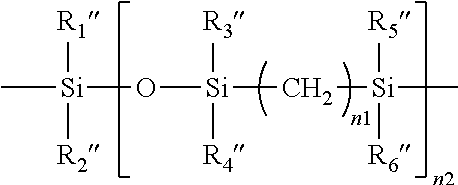Poly(oxazoline-co-ethyleneimine)-epichlorohydrin copolymers and uses thereof
a technology of oxazoline and coethyleneimine, which is applied in the field of poly(oxazolinecoethyleneimine)epichlorohydrin copolymers, can solve the problems of haziness of the resultant lenses, low cost effectiveness of silicone hydrogel contact lens plasma treatment, and inability to provide a durable hydrophilic surfa
- Summary
- Abstract
- Description
- Claims
- Application Information
AI Technical Summary
Benefits of technology
Problems solved by technology
Method used
Image
Examples
example 1
[0188]500 mL of DI water is added to a 3 liter round bottom flask. The flask has at least 3 necks. The center neck contains a glass stir rod and paddle for stirring the formation. Another neck contains a reflux condenser cooled to about 2° C. 100 grams of poly(2-ethyl-2-oxazoline) (PEOZO 50 kDa) is added to the flask over about 15 minutes while stirring at about 150 rpm. After addition is complete, stirring continues until the PEOZO is completely dissolved. 1000 mL of 10% HCl is added to the PEOZO solution over about 15 minutes with stirring. The stir rate is increased to about 200 rpm. A thermocouple is added to the third neck to monitor temperature. A heating mantle is used to heat the solution up to the boiling point. This temperature of about 102° C. is maintained for a specified period of time (1 to 7 hours). After the specified time, the heating mantle is removed and the solution is allowed to cool. When the solution cools to less than 70° C., neutralization can begin. 5N NaOH...
example 2
[0189]The solution from Example 1 is purified by ultrafiltration using 3 kDa regenerated cellulose membranes from Millipore. The solution is concentrated to about 2 liters, if necessary, and about 40 liters of water is collected as permeate through the filters. During the purification pH should be adjusted to maintain a pH between 9 and 11. The conductivity of the permeate should also be less than 10 μS / cm at the end. Some of the sample is then isolated by freeze-drying and used for 1H NMR analysis. NMR is useful to determine purity and the percentage of amide hydrolysis. Table 1 below shows the % amide hydrolyzed as function of reaction time as determined by 1H NMR.
TABLE 1Sample3A3B3C3DReaction time (hours)1357Amide Hydrolysis (%)32768992
example 3
[0190]This example illustrates how to prepare poly(2-oxazoline-co-ethylenimine)-epichlorohydrin copolymers according to procedures similar to what described in the paper of Obokata and coworkers (J. Appl. Polym. Sci. 2005, 97, 2249, herein incorporated by reference in its entirety) and as illustrated in the following scheme.
[0191]A hydrolyzed polyoxazoline prepared in Example 2 is dissolved in an polar solvent such as acetonitrile, tetrahydrofuran, 1,4-dioxane, water or a combination of any of the two followed by adding desire amount of epichlorhydrin from 5% to 100% according to the total amine content, preferred from 30% to 70%. The mixture is stirred in a desired temperature range from 0° C. to 70° C., preferred 20° C. to 30° C. for 1 to 5 hours depending upon the applied reaction temperature. The most desired combination according to the current experimental results is 25° C. for 3 hours in which the epichlorhydrin is fully reacted to secondary amine without having side reaction...
PUM
| Property | Measurement | Unit |
|---|---|---|
| weight average molecular weight Mw | aaaaa | aaaaa |
| weight average molecular weight | aaaaa | aaaaa |
| weight average molecular weight | aaaaa | aaaaa |
Abstract
Description
Claims
Application Information
 Login to View More
Login to View More - R&D
- Intellectual Property
- Life Sciences
- Materials
- Tech Scout
- Unparalleled Data Quality
- Higher Quality Content
- 60% Fewer Hallucinations
Browse by: Latest US Patents, China's latest patents, Technical Efficacy Thesaurus, Application Domain, Technology Topic, Popular Technical Reports.
© 2025 PatSnap. All rights reserved.Legal|Privacy policy|Modern Slavery Act Transparency Statement|Sitemap|About US| Contact US: help@patsnap.com



